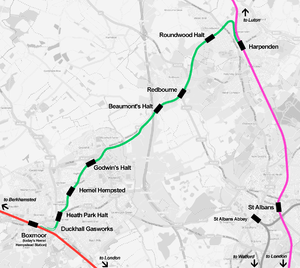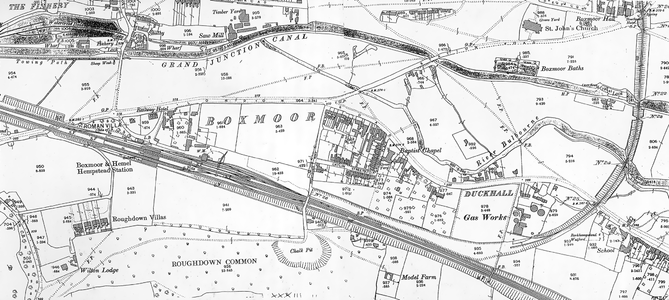Hemel Hempstead railway station
Hemel Hempstead railway station is on the West Coast Main Line, on the western edge of the town of Hemel Hempstead, Hertfordshire, England. The station is 24 1⁄2 miles (39.4 km) north-west of London Euston on the West Coast Main Line. Hemel Hempstead is managed by London Northwestern Railway and all train services are operated by London Northwestern Railway and Southern.
| Hemel Hempstead | |
|---|---|
.jpg) | |
| Location | |
| Place | Hemel Hempstead |
| Local authority | Borough of Dacorum |
| Coordinates | 51.742°N 0.491°W |
| Grid reference | TL042059 |
| Operations | |
| Station code | HML |
| Managed by | London Northwestern Railway |
| Number of platforms | 4 |
| DfT category | C2 |
| Live arrivals/departures, station information and onward connections from National Rail Enquiries | |
| Annual rail passenger usage* | |
| 2014/15 | |
| 2015/16 | |
| 2016/17 | |
| 2017/18 | |
| 2018/19 | |
| – Interchange | 33,282 |
| History | |
| Original company | London and Birmingham Railway |
| Pre-grouping | London and North Western Railway |
| Post-grouping | London, Midland and Scottish Railway |
| 20 July 1837 | Opened as Boxmoor |
| 17 December 1912 | Renamed Boxmoor and Hemel Hempstead |
| 2 June 1924 | Renamed Boxmoor |
| 1 September 1924 | Renamed Boxmoor and Hemel Hempstead |
| 1 July 1930 | Renamed Hemel Hempstead and Boxmoor |
| 20 December 1963 | Renamed Hemel Hempstead |
| National Rail – UK railway stations | |
| |
Hemel Hempstead railway station is one of two railway stations now serving the town, the other being Apsley. Both were built when Hemel Hempstead was still small; before it was designated a New Town in 1946 and grew rapidly in size. Bus services run from there to the town centre. Also in the vicinity of the station are two pubs and the Grand Union Canal, about 110 yd (100 m) away.
There are four full-length (12 car) through platforms and one disused south-facing bay (on the slow lines).
Ticket Barriers are in operation.
History
Hemel Hempstead station was opened by the London and Birmingham Railway on 20 July 1837. Originally called Boxmoor station, it was the first terminus of the new line from the south, engineered by Robert Stephenson, which was subsequently extended to Tring in October of the same year and then to Birmingham in 1838.[1] The decision to locate the station 1 mile (1.6 km) outside Hemel Hempstead town centre was a result of the opposition faced by the L&BR during construction of the line. There were vociferous protests from local landowners who sought to protect their estates from invasion by the "iron horse", including influential figures such as the Earl of Essex (Cassiobury Estate), the Earl of Clarendon (The Grove Estate) and the eminent anatomist Sir Astley Cooper (Gadebridge Estate). Turbulent public meetings were held in Berkhamsted and Watford, and in the House of Lords on 22 June 1832, Lord Brownlow of Ashridge voiced his opposition to "the forcing of the proposed railway through the land and property of so great a proportion of dissentient landowners." In order to obtain Parliamentary approval, the L&BR was forced to choose an alternative route which was less favourable to Hemel Hempstead but satisfied Hertfordshire landowners.[2]
In 1846 the L&BR was taken over by the London and North Western Railway (LNWR). As competition with the rival Midland Railway's new line through Hemel town centre increased, the LNWR operated a horse bus into the town, later replaced by a motor bus service, to poach passengers onto their own, less conveniently placed railway line.[3] In 1912 the LNWR renamed the station Boxmoor and Hemel Hempstead. The LNWR was absorbed into the new London, Midland and Scottish Railway (LMS) in 1923 as part of the Grouping of British railway companies, and in 1930 the Boxmoor and Hemel Hempstead station name was changed to Hemel Hempstead and Boxmoor. Following nationalisation in 1948, the station was under the ownership of the London Midland Region of British Railways; the line was electrified and in 1963 the Boxmoor name was dropped, and the station was simply known as Hemel Hempstead.

For many years, Hemel Hempstead station was almost a junction – a railway embankment on the south (down) side of the station led to the end of the Nickey Line, a branch line which ran through the town centre to Harpenden. The line was opened in 1877 by the Midland Railway and extended to transport coal to Duckhall gasworks, close to Boxmoor. However, due to rivalry between the Midland Railway and the London & North Western Railway, no direct connection was made between the two lines – the Nickey Line terminated approximately 1⁄2 mile (0.80 km) away from Boxmoor station at the gasworks terminus. Only occasional freight trains ran this far; passenger trains terminated in the town centre at Heath Park Halt, and there was also a town centre station on the line called Hemel Hempsted.[notes 1] Passenger services ceased on the Nickey Line in 1947 although it remained in use as a goods line.[4]
It was only in the last months of the Nickey Line's operations that a rail link was built at Boxmoor. Hemel Hempstead had been designated as a New Town and the town centre redevelopment plans included the demolition of the Nickey Line. In order to maintain a coal service to the gasworks, a link was built in 1959 connecting the Nickey Line to the West Coast Main Line via sidings at Boxmoor. This link was for goods trains only and no passenger service was ever provided, but it only remained in operation for six months; the gasworks shut down and the link was closed. The following year the railway viaduct over Marlowes in the town centre was demolished, removing Hemel Hempstead's last town centre rail link.[5]
The nearby crossover at Bourne End was the site of a serious accident on 30 September 1945, when a Scottish express derailed after passing over the junction at excessive speed. The coaches rolled down a high embankment, and forty-three lives were lost.
- The Nickey Line at Boxmoor
 An 1898 OS map shows the southern extend of the Nickey Line, which terminated 1⁄2 mile (0.80 km) away from Boxmoor station; a mainline link opened in 1959 only lasted for 6 months
An 1898 OS map shows the southern extend of the Nickey Line, which terminated 1⁄2 mile (0.80 km) away from Boxmoor station; a mainline link opened in 1959 only lasted for 6 months.jpg) The sidings at Boxmoor, looking north
The sidings at Boxmoor, looking north
Services
West London Route | |||||||||||||||||||||||||||||||||||||||||||||||||||||||||||||||||||||||||||||||||||||||||||||||||||||||||||||||||||||||||||||||||||||||||||||||||||||||||||||||||||||||||||||||||||||||||||||||||||||||||||||||||||||||||
|---|---|---|---|---|---|---|---|---|---|---|---|---|---|---|---|---|---|---|---|---|---|---|---|---|---|---|---|---|---|---|---|---|---|---|---|---|---|---|---|---|---|---|---|---|---|---|---|---|---|---|---|---|---|---|---|---|---|---|---|---|---|---|---|---|---|---|---|---|---|---|---|---|---|---|---|---|---|---|---|---|---|---|---|---|---|---|---|---|---|---|---|---|---|---|---|---|---|---|---|---|---|---|---|---|---|---|---|---|---|---|---|---|---|---|---|---|---|---|---|---|---|---|---|---|---|---|---|---|---|---|---|---|---|---|---|---|---|---|---|---|---|---|---|---|---|---|---|---|---|---|---|---|---|---|---|---|---|---|---|---|---|---|---|---|---|---|---|---|---|---|---|---|---|---|---|---|---|---|---|---|---|---|---|---|---|---|---|---|---|---|---|---|---|---|---|---|---|---|---|---|---|---|---|---|---|---|---|---|---|---|---|---|---|---|---|---|---|
| |||||||||||||||||||||||||||||||||||||||||||||||||||||||||||||||||||||||||||||||||||||||||||||||||||||||||||||||||||||||||||||||||||||||||||||||||||||||||||||||||||||||||||||||||||||||||||||||||||||||||||||||||||||||||
Hemel Hempstead is served by frequent trains on the West Coast Main Line between London Euston-Tring and Milton Keynes operated by London Northwestern Railway. There are additional direct services between London Euston - Leighton Buzzard, Bletchley and Rugby. There is also one train to and from Crewe on weekdays and some services to/from Crewe on Sundays. Hemel Hempstead is also served by the Southern cross-London service which runs to East Croydon in South London via the West London Line.
A typical off-peak weekday consists of the following services, in trains per hour (tph):[6]
- 4tph to London Euston, operated by London Northwestern Railway
- 1tph to South Croydon, operated by Southern
- 2tph to Tring, operated by London Northwestern Railway
- 1tph to Milton Keynes Central, operated by London Northwestern Railway
- 1tph to Milton Keynes Central, operated by Southern
- 1tph to Northampton, operated by London Northwestern Railway
| Preceding station | Following station | |||
|---|---|---|---|---|
| Berkhamsted | London Northwestern Railway West Coast Main Line |
Watford Junction or Apsley | ||
| Southern West London Route | ||||
Notes
- Hemel Hempsted [sic] was the spelling used widely by the Midland Railway company at the time on ticketing and signage.
References
- Smith, Denis, ed. (2001). London and the Thames Valley. London: Telford. p. 157. ISBN 9780727728760. Retrieved 6 June 2013.
- Birtchnell, Percy (1960). "Our Communications". A Short History of Berkhamsted. ISBN 9781871372007.
- Woodward 1996 pp.99-101
- Woodward 1996 p.57
- Woodward 1996 p.135
- "Timetables". London North Western Railway. Retrieved 7 April 2019.
- Bibliography
- The Harpenden to Hemel Hempstead Railway – The Nickey Line. (1996) Sue and Geoff Woodward, Oakwood Press, ISBN 0-85361-502-0
External links
| Wikimedia Commons has media related to Hemel Hempstead railway station. |
- Train times and station information for Hemel Hempstead railway station from National Rail